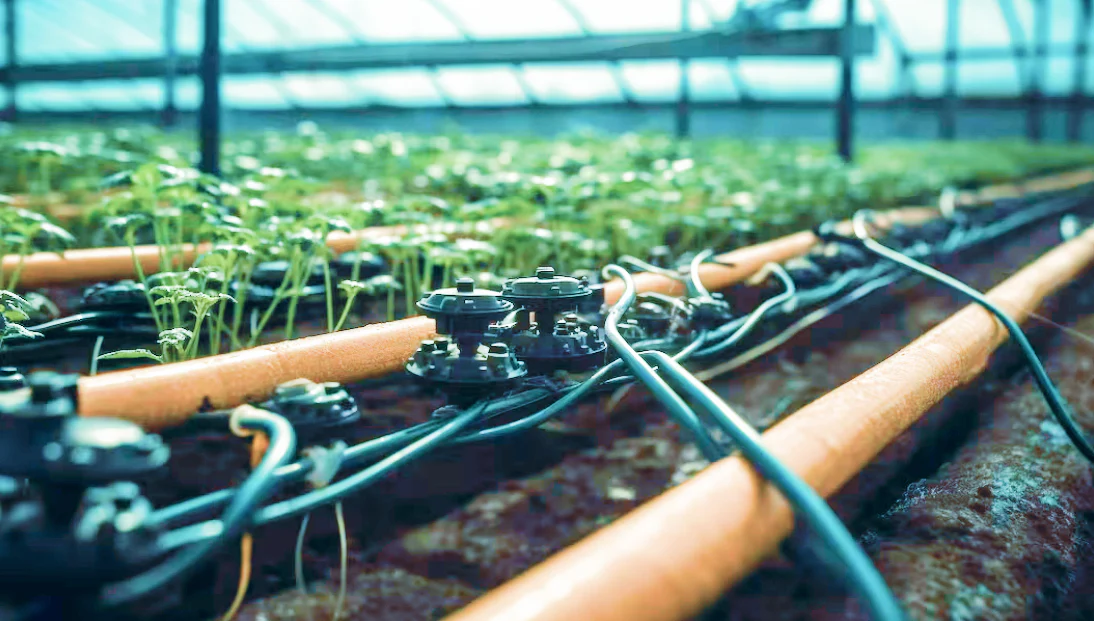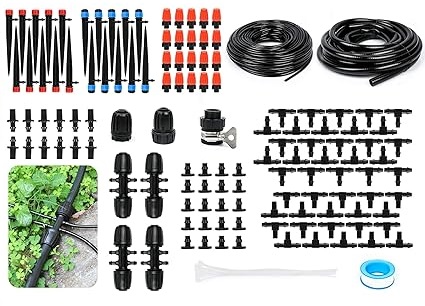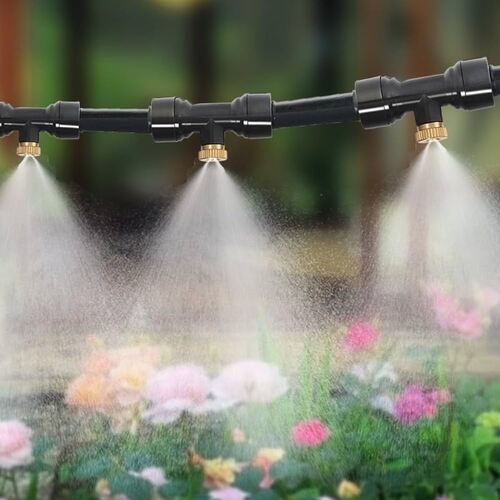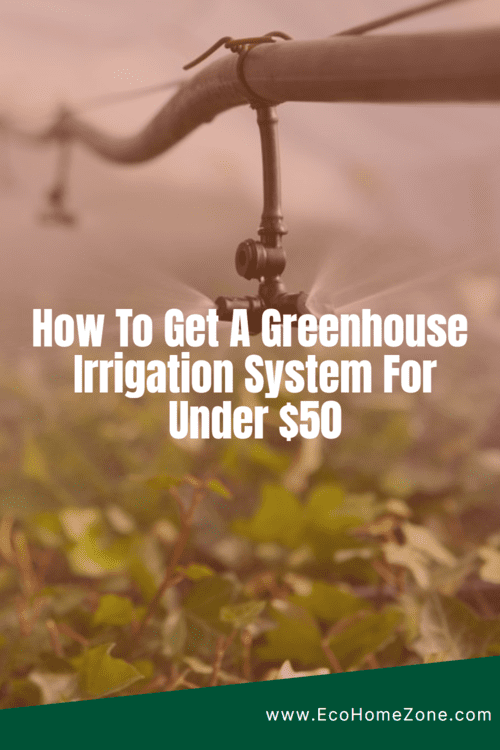Greenhouse Watering System 101: Everything You Need To Know
Struggling to keep your plants healthy? A proper greenhouse watering system can make all the difference. This blog will explore everything you need to know about choosing, using, and maintaining greenhouse watering systems.
Let’s get into it.
Table Of Contents
Why Is A Greenhouse Watering System Important?
A greenhouse watering system is super handy because it makes sure all the plants get the right amount of water they need to grow well, without any guesswork. Imagine trying to water a bunch of plants by hand—it can be tiring and you might miss some or overwater others.

A watering system takes care of this by evenly distributing water at set times, which is a big help, especially in a controlled environment like a greenhouse where everything from temperature to moisture matters a lot.
Plus, it saves a lot of time and effort, allowing you to focus on other important tasks in the greenhouse. It’s like having a reliable helper that ensures your plants stay healthy and happy!
What Are The Pro’s And Cons Of Using A Greenhouse Watering System?
Like everything, there are pros and cons to using a watering system. So let’s quickly go through these to make sure that we’re on the same page.
Pros
| Saves Water: | These systems are designed to use water efficiently, reducing waste by targeting water directly where plants need it most. |
| Saves Time: | Automated systems mean you don’t have to water by hand, freeing up your time for other gardening tasks or just to relax and enjoy your greenhouse |
| Consistent Watering: | Machines don’t forget to water or have off days. They deliver the right amount of water at the right time, which can help plants grow better. |
| Reduces Weeds and Diseases: | By keeping water off the leaves and only on the soil, drip systems reduce the risk of some plant diseases. Also, watering directly at the root zone can help prevent weed seeds from germinating in the paths or between plants. |
Cons
| Cost: | Setting up a greenhouse watering system can be expensive. The initial outlay for equipment and installation might not fit everyone’s budget. |
| Maintenance: | Like any system with moving parts and water involved, these systems can break down or clog, requiring maintenance and sometimes repairs |
| Complex Setup: | Installing a system can be complicated. You might need to do some research or hire help to get it set up correctly. |
| Overwatering Risk: | If not monitored or set up properly, automated systems can lead to overwatering, which can harm plants just as much as not watering enough. |
Overall, while there are some downsides, many find that the benefits of using a greenhouse watering system outweigh the drawbacks, especially if you’re managing a large space or specific types of plants that need consistent care (1).
Which Watering Systems Are Available?

Drip Irrigation: This is a really popular method because it’s super efficient. It works by delivering water directly to the base of each plant through small tubes or drip emitters. This means less water wastage and the plants get exactly what they need.
Sprinkler Systems: These are like the sprinklers you might use in a garden or lawn. They can cover a large area by spraying water over the tops of the plants. This can be good for some plants, but it’s not always the best choice for others that don’t like water on their leaves.
Misting Systems: These are especially great for tropical plants that love humidity. Misting systems spray a fine mist over the plants, which can help with both watering and maintaining the humidity levels inside the greenhouse.
Capillary Mats: These are a bit less common but super cool. They involve placing mats that absorb water underneath the plants. The roots then draw water up from the mats as needed. This system is very water-efficient and great for smaller or potted plants.
Ebb and Flow Systems: These are often used in hydroponic setups (where plants grow without soil). The system works by flooding the plant roots with water and then draining it back into a reservoir to be reused.
Each system has its own benefits depending on what kinds of plants you’re growing and how much time and resources you want to invest. So, it’s all about finding what works best for your particular greenhouse.
Choosing the Right Greenhouse Watering System
Choosing the right watering system for your greenhouse involves a few key steps. Here’s how you can think about it in a simple way:
1. Size and Capacity: First, think about how big your greenhouse is and how much water your plants need. You want a system that can handle the whole area and give enough water to all your plants. It’s like making sure you have enough sprinklers to cover your whole lawn.
2. Misting System Features: If you’re thinking about a misting system, look for:
High-Pressure Nozzles: These spray tiny water droplets to cover plants evenly without using too much water.
Adjustable Settings: It’s handy to be able to change how much mist comes out depending on what your plants need and the weather conditions. Make sure the misting system you pick can do what you need for your particular setup.
3. Automation with Water Timers: Using water timers is like setting an alarm to water your plants. You can program them to turn on and off at certain times so your plants always get watered, even if you’re not around. This is a great way to make sure your plants stay happy and you don’t waste water or your utility bills.
By considering these factors, you’ll be able to pick a watering system that’s just right for your greenhouse, keeping your plants thriving while saving you time and effort. Plus, it’s a smart move for both the environment and your wallet!
Which Greenhouse Watering System Should You Buy?
It can get a bit overwhelming choosing a greenhouse watering system so let me help you out with one that I’ve used in the past.
If you want a simple option, then I would recommend that you use a micro drip irrigation system:
Here’s what you can buy: MIXC Micro Drip Irrigation Kit

Where To Buy: Amazon
Specs & Features:
– Size of 226 ft
– Suitable for 160 feet of irrigation area.
The MIXC 226FT micro drip irrigation kit is designed to make watering your plants straightforward and efficient, covering an area of 160 square feet. It includes over 226 feet of tubing to set up a system that waters all your plants at once. The kit is easy to install with no need for digging or plumbing—just follow the included instructions. It features a special connector that splits the water into 16 different paths, helping to boost water pressure and ensure every part of your system gets enough water. This kit also offers three types of sprayers with adjustable nozzles, so you can tailor the water flow to meet the specific needs of your plants, from a fine mist to a steady spray. Using this system can help you save up to 70% on water by delivering it directly to the root zone where it’s needed most.
| Check Price ➡️ Amazon |
Here’s an overview of how it works:

How Do You Set Up This Greenhouse Watering System?
Installing a micro drip irrigation system is pretty straightforward, and you can do it yourself without needing any fancy tools or plumbing skills.
Here’s a quick video overview:
Instructions:
Plan Your Layout: Before you start, think about where all your plants are and how you can run your tubing to reach them all. Sketching it out on a piece of paper can be really helpful.
Lay Out the Tubing: Start by laying the main tubing along your planned route. Don’t connect anything yet; just lay it out on the ground to make sure it reaches everywhere you need it to go.
Cut and Connect: Once your main line is in place, you can start cutting the smaller tubing that will go to each plant. Use the connectors from your kit to attach these smaller lines to the main line. Make sure everything is snug and secure so you don’t have any leaks.
Install the Emitters: Attach the drip emitters or sprayers at the end of each small line near your plants. These are what will actually deliver the water right to the roots. You can adjust these to control how much water each plant gets.
Test Your System: Before you bury any tubing or finalize everything, turn on the water to make sure it’s working correctly. Look for leaks or any emitters that aren’t working, and adjust as needed.
Secure and Bury: Once everything is working, you can secure your tubing to the ground with stakes and bury it slightly under the soil or mulch if you want it out of sight. Just make sure you don’t put it so deep that it gets damaged or you can’t reach it for repairs.
And that’s it! Once you’re done, your plants will be all set to get the right amount of water with minimal effort from you. It’s a great way to keep your garden thriving.
Are There Alternatives?
Yes – you can look into getting a misting system which are extremely effective.
| Here’s all the information you need: How To Choose The Best Greenhouse Misting System For Plant Growth |
Maintenance and Troubleshooting
Proper maintenance of your greenhouse watering system is essential for performance. Routine cleaning and upkeep are crucial to keep the system in good working condition, ensuring healthy growth for your plants.

Routine Cleaning and Upkeep
- Remove any debris and dirt from the misting nozzles and filter to ensure proper water flow. Inspect the tubing for any clogs or blockages and clear them as needed.
- Check the water timers for accuracy and adjust if necessary to maintain consistent watering schedules.
- Clean the drip emitters to prevent clogging and ensure even water distribution to all plants.
- Examine the main water supply for leaks or damage, repairing any issues promptly to avoid water wastage.
- Replace any worn or damaged parts such as hoses, connectors, or nozzles to maintain efficient operation.
- Regularly monitor the system for any signs of wear or deterioration, addressing issues promptly to prevent larger problems.
Solving Common Watering System Issues
- Adjust the water pressure to prevent clogging and ensure even distribution.
- Check for leaks in the tubing and replace damaged sections promptly.
- Clear any debris from the filters to maintain proper water flow. Inspect the nozzles regularly and clean or replace them if clogged.
- Calibrate the timer settings to match plant needs and water requirements accurately.
- Monitor for any system malfunctions and address them promptly to avoid plant stress.
Conclusion
Wrapping up, having a greenhouse watering system really takes the stress out of keeping your plants healthy and hydrated. Whether you go for a drip system, a misting setup, or something else, you’ll find it can save you a lot of time and effort. Remember, the key is to choose the system that fits your greenhouse size, your budget, and the specific needs of your plants.

Setting up the system might seem like a bit of work at first, but once you get it running, you’ll wonder how you ever managed without it. Plus, with regular maintenance and some troubleshooting now and then, your system will keep running smoothly and keep your plants thriving. It’s all about giving your plants the best care with the least hassle, so you can enjoy a lush, healthy greenhouse year-round.
| Here are some of my favorite greenhouse accessories: 14 Best Greenhouse Accessories That You Need In 2024 |
FAQ
What is the most reliable watering system in a greenhouse?
The most reliable system tends to be the drip irrigation system. It’s really efficient because it delivers water directly to where each plant can absorb it best — at the roots. This not only saves water but also helps keep the plants consistently hydrated, which is great for their growth.
How much water does a greenhouse need per day?
The amount of water a greenhouse needs each day can vary widely depending on factors like the type of plants, the climate, and the season. On average, a greenhouse might use about 0.2 to 1 gallon of water per square foot per week. It’s best to check the specific water needs of your plants and monitor the soil moisture regularly.
What are the three most common types of greenhouse irrigation?
- Drip Irrigation: Delivers water directly to the base of each plant through a network of tubing and emitters. It’s water-efficient and reduces the growth of weeds.
- Sprinkler Systems: These spray water over the plants from above, similar to rain. They are good for larger areas but can be less water-efficient than drip systems.
- Misting Systems: Ideal for plants that need high humidity, misting systems spray a fine mist over the plants at regular intervals. This helps with both watering and maintaining the necessary humidity levels.
What is the difference between a sprinkler system and a drip system?
A sprinkler system waters plants by spraying water over them from above, which can simulate natural rainfall. This is good for watering a large area evenly but can lead to some water wastage and may not be suitable for all types of plants. A drip system, on the other hand, delivers water directly to the soil at the base of each plant through small emitters. It’s more water-efficient because it minimizes evaporation and runoff, and it keeps foliage dry, which can help prevent some plant diseases.
How to make a greenhouse watering system?
To make a basic greenhouse watering system, you could start with a simple drip irrigation setup. Here’s how:
- Design Your Layout: Plan where all your plants are and how you can run tubing to each plant.
- Lay the Tubing: Roll out the main water line around your greenhouse and use smaller connector lines to reach each plant.
- Install Emitters: Attach drip emitters at points along the tubing near the base of each plant. Adjust the flow on each emitter based on what the plant needs.
- Connect to Water Source: Hook up your main line to a water source. You might also want to install a filter to keep the system clean and a timer to automate watering times.
- Test and Adjust: Turn on the water to check for leaks and make sure each plant is getting enough water. Adjust as needed.
With these setups, your greenhouse will be well on its way to having a happy and healthy growing environment!

References:
1 – David Beaulieu, All About Automatic Irrigation Systems, taken from: https://www.thespruce.com/automatic-irrigation-systems-2130775




